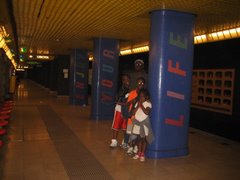 Naples
Naples is very different from Rome and from all of the little Medieval towns we've visited--it's

a city. It's bustling, busy, large, economically diverse, and dirty. We didn't bother to see the historical center and instead stuck close to the bay, which was beautiful. We loved Piazza Plebiscito, with is columns and live band.
We also enjoyed imagining life in the two large castles/fortresses on the bay.
Just before a dinner of pizza, we shared a mixed seafood antipasta. The kids learned that they like squid, mussels, and clams. Yum!

We spent Sunday exploring the excavation of
Herculaneum (Ercolano). This seaside resort was covered in ash and lava when Mt. Vesuvius erupted in 79AD. Because it was covered so quickly, archaeologists not only found the remains of buildings but petrified, organic materials. They discovered bread prepped for baking, beans, and, yes, skeletons. The eruption of the volcano was recorded by
Pliny the Younger, who described the darkening sky, the ash and the wailing of residents. Listening to a reading of his letters on our audioguide made the tour of the excavation even more poignant.
It was very cool to see how people

lived here. Most of the large homes were formed around open atriums, which contained private gardens. Homes also had plumbing--water was carried in lead pipes to the kitchen and toilets. Paint decorated walls and mosaics covered most of the floors. And there were large, public baths for men and women.



























